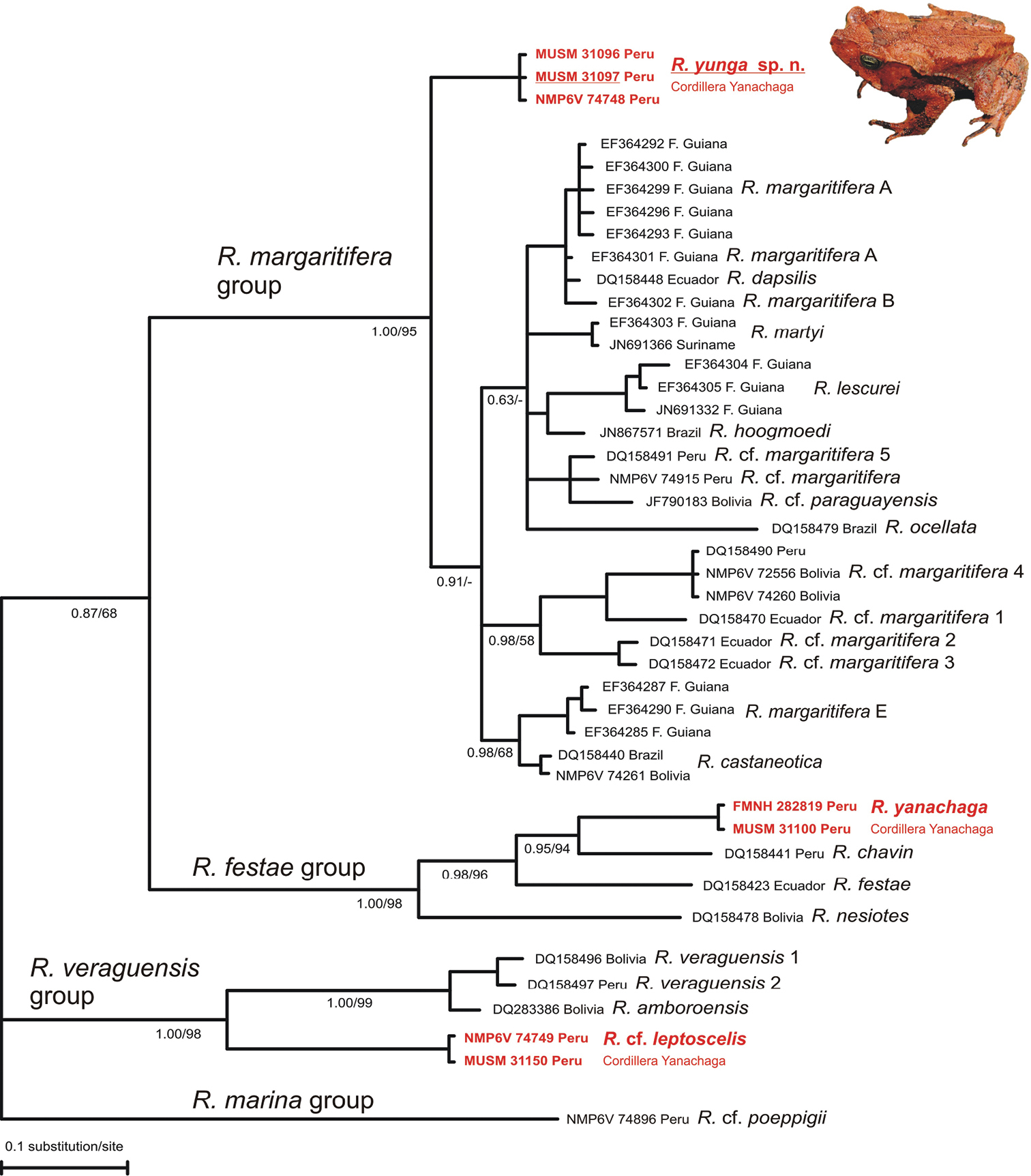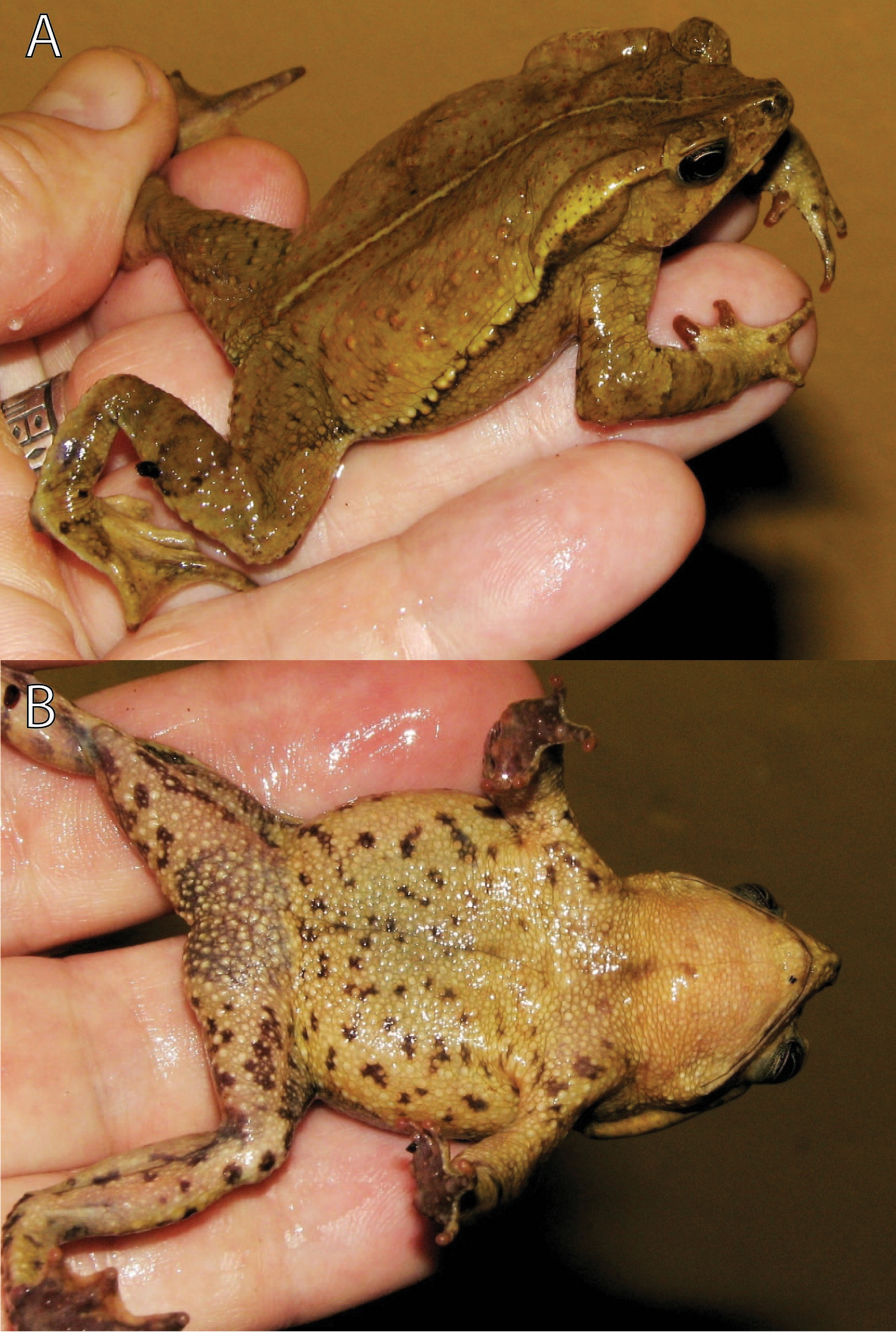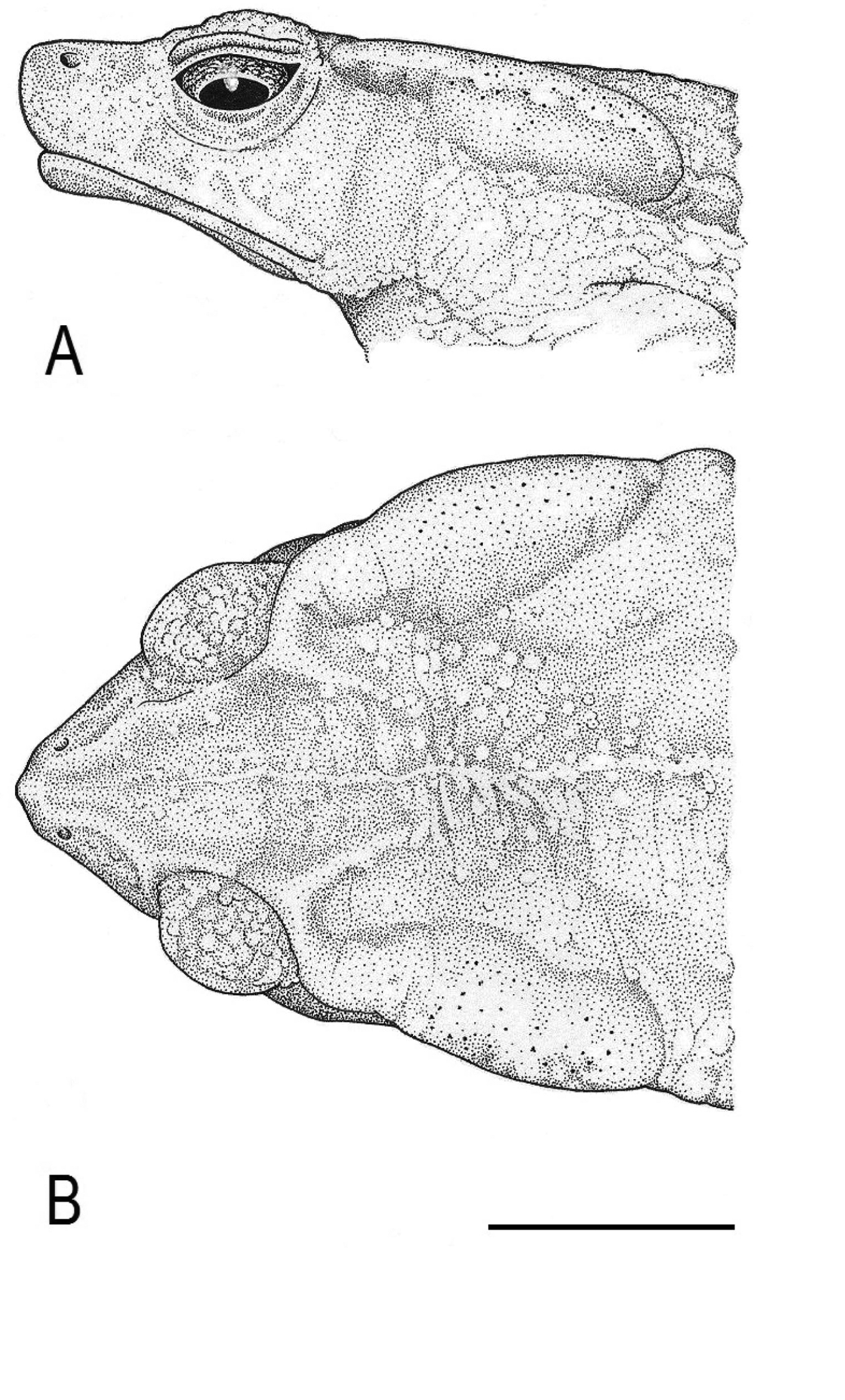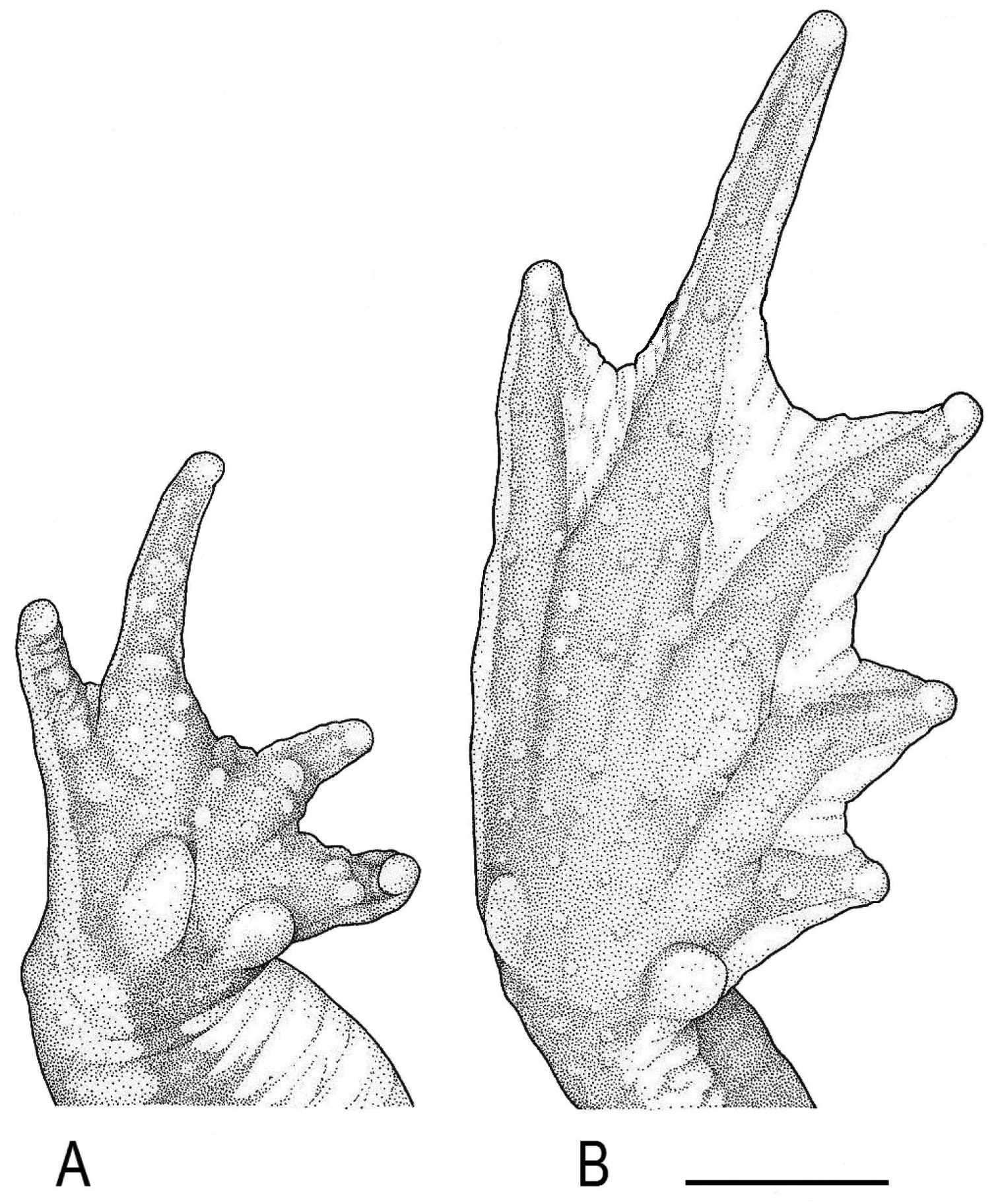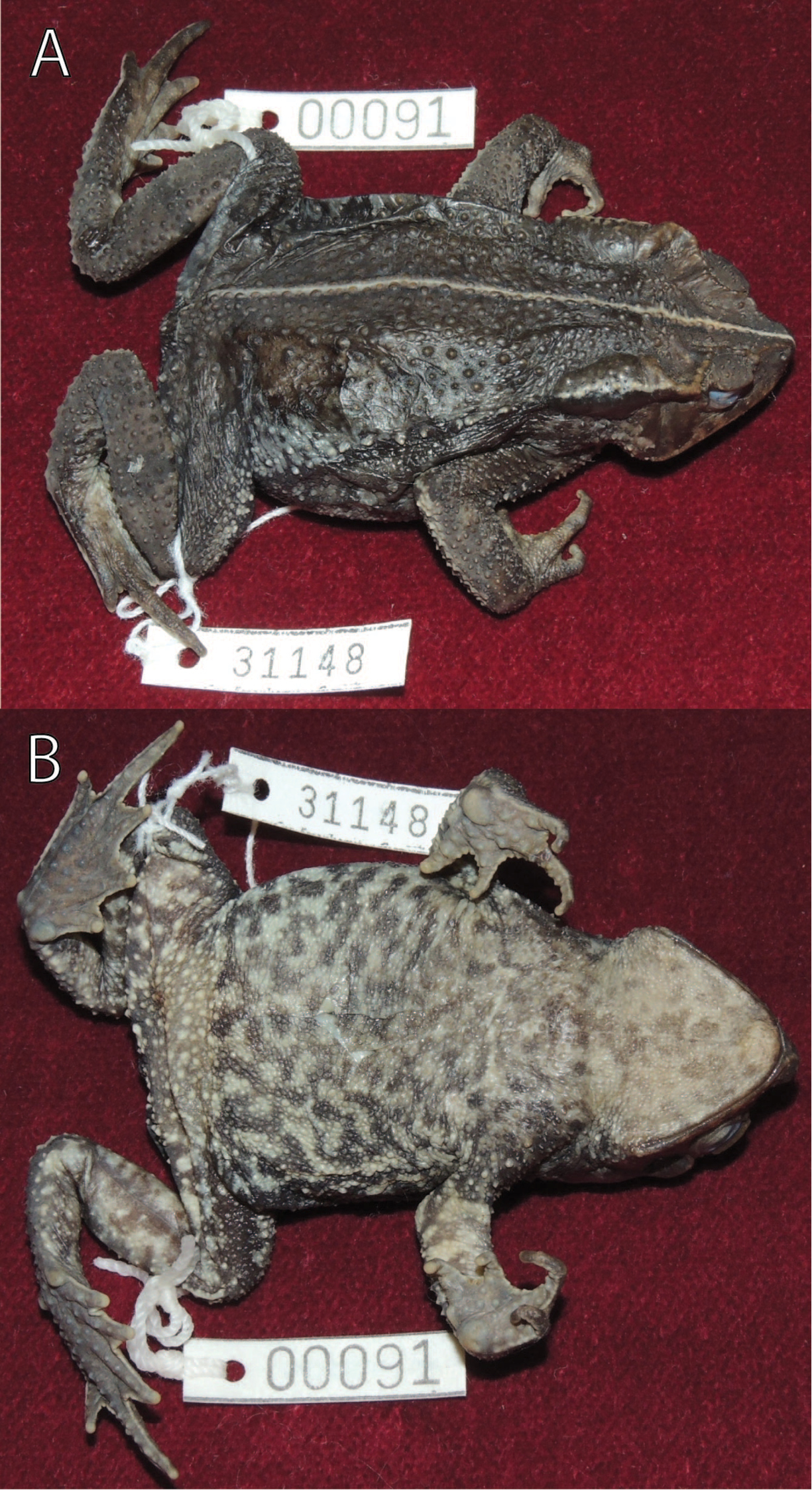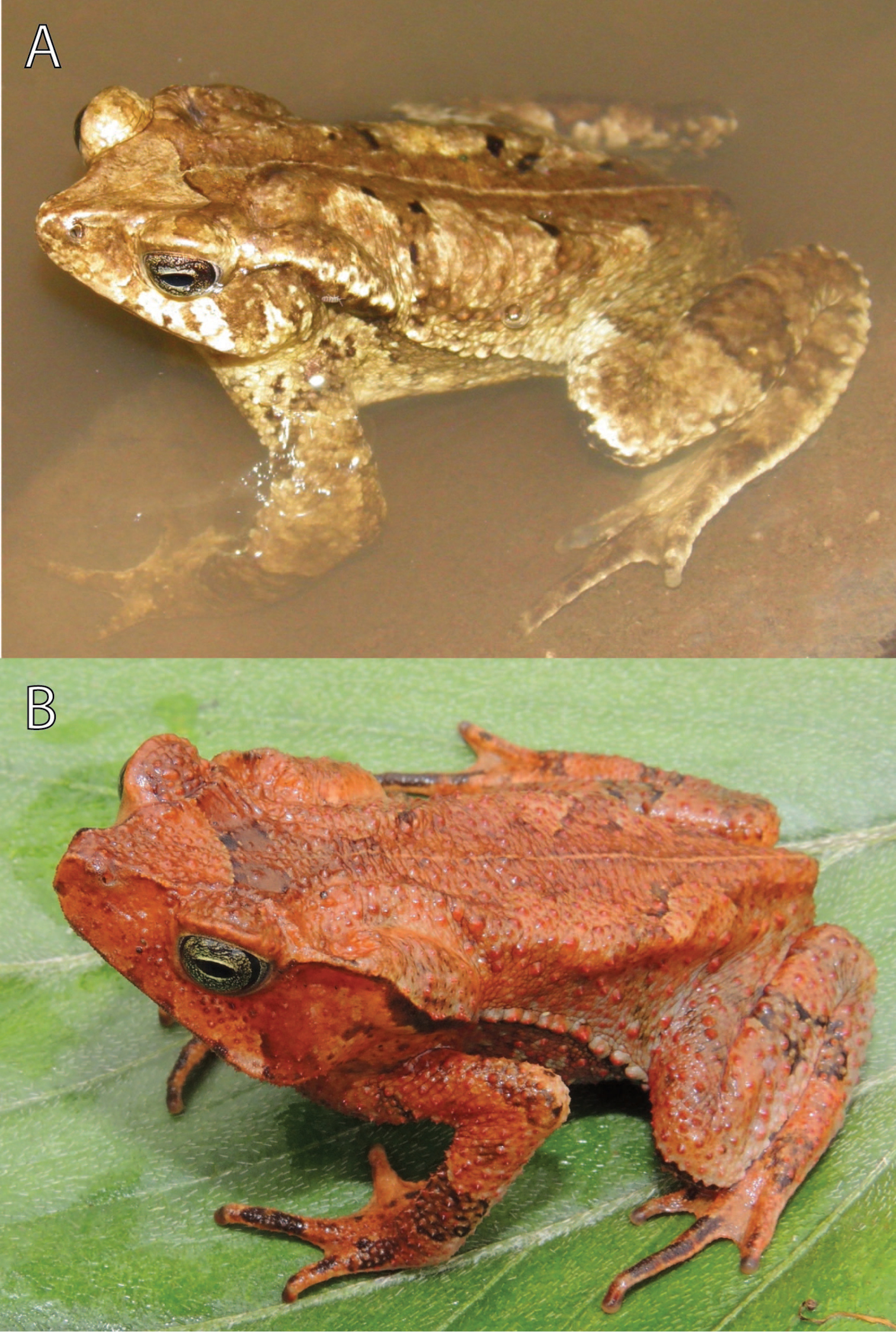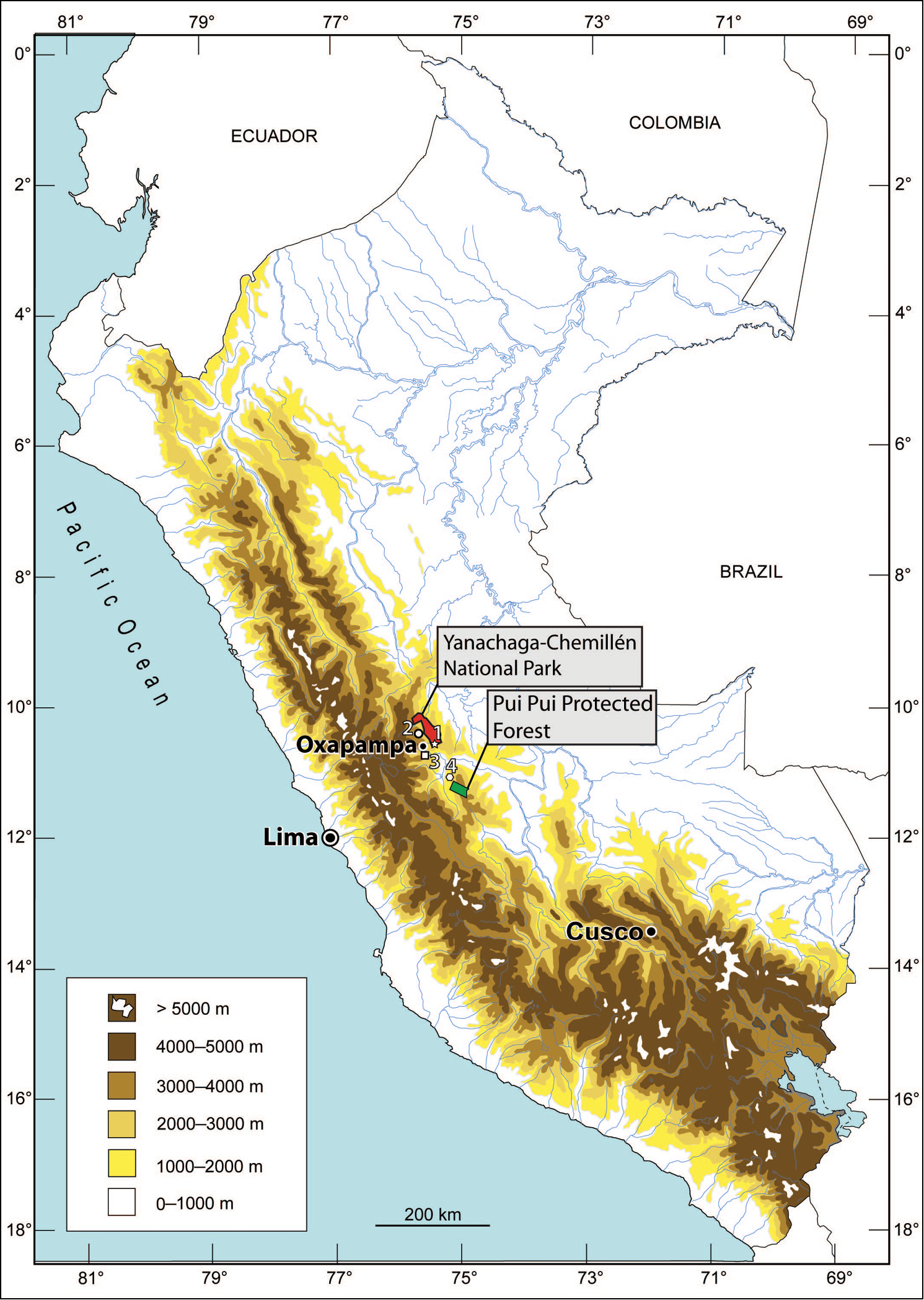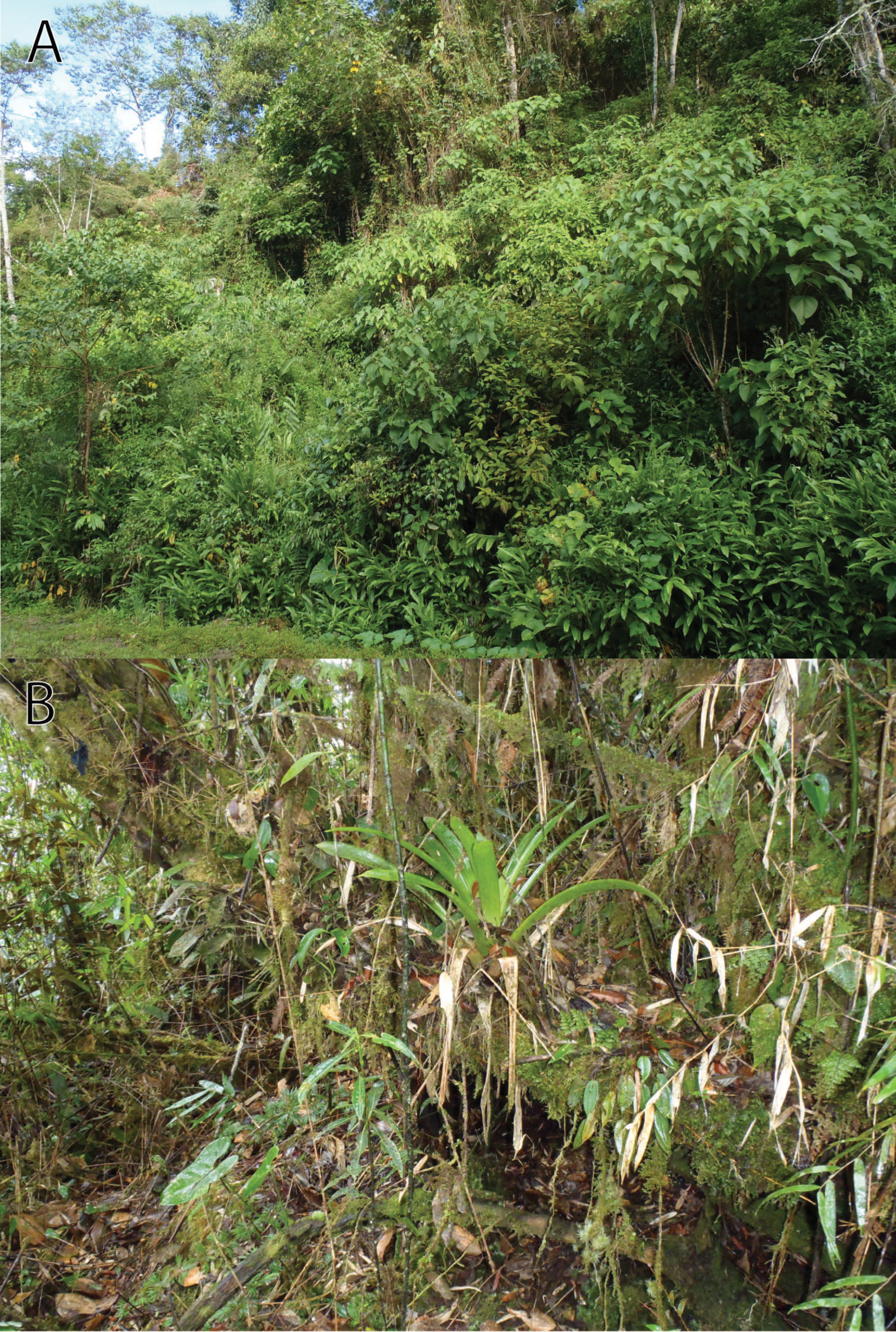






(C) 2014 Jiří Moravec. This is an open access article distributed under the terms of the Creative Commons Attribution License (CC BY 4.0), which permits unrestricted use, distribution, and reproduction in any medium, provided the original author and source are credited.
For reference, use of the paginated PDF or printed version of this article is recommended.
Citation: Moravec J, Lehr E, Cusi JC, Córdova JH, Gvoždík V (2014) A new species of the Rhinella margaritifera species group (Anura, Bufonidae) from the montane forest of the Selva Central, Peru. ZooKeys 371: 35–56. doi: 10.3897/zookeys.371.6580
We describe a new species of the bufonid toad genus Rhinella from transition montane forest of the buffer zones of the Yanachaga-Chemillén National Park and the Pui Pui Protected Forest (eastern slopes of Andes, Selva Central, Peru). The new species belongs to the Rhinella margaritifera species group (confirmed by mtDNA data) and differs from all its members by the absence of tympanic membrane and tympanic annulus. It is characterized by medium size (SVL 57.5–65.5 mm, n = 5), moderately developed cranial crests, absence of neural crest of vertebrae, absence of bone protrusion at angle of jaw, presence of lateral rows of enlarged tubercles, and absence of subgular vocal sac and vocal slits in males. In addition, based on the molecular phylogenetic analyses of selected Rhinella species we propose the monophylum containing R. chavin, R. festae, R. macrorhina, R. manu, R. nesiotes, R. rostrata, and R. yanachaga as a new species group under the name Rhinella festae species group.
Se describe una nueva especie de sapo Bufonidae del género Rhinella presente en los bosques montanos transicionales de la zona de amortiguamiento del Parque Nacional Yanachaga Chemillén y el Bosque de Protección Pui Pui (Vertiente Oriental de los Andes, Selva Central, Perú). La nueva especie pertenece al grupo de especies Rhinella margaritifera (confirmado con datos de DNAmt) y difiere de todos sus miembros por la ausencia de membrana timpánica y anillo timpánico. Se caracteriza por su tamaño mediano (SVL 57.5–65.5 mm), crestas craneales moderadamente desarrolladas, ausencia de una cresta neural, ausencia de protuberancia ósea en el ángulo mandibular, presencia de filas laterales de tubérculos agrandados, y ausencia de saco vocal subgular y hendiduras vocales en los machos. Además, basado en los análisis filogenéticos moleculares de especies seleccionadas de Rhinella se propone la monofilia que contiene a R. chavin, R. festae, R. macrorhina, R. manu, R. nesiotes, R. rostrata y R. yanachaga como un nuevo grupo de especies bajo el nombre de grupo de especies Rhinella festae.
Amphibia, Rhinella yunga, new species, Rhinella festae, new species group, Andes
Neotropical toads of the Rhinella margaritifera species group (formerly Bufo margaritifer or Bufo typhonius species group/complex) are represented by several members of anuran communities inhabiting floor of tropical humid rainforest of South America. These medium-sized (SVL ca. 31–81 mm; e.g.,
Currently, 16 species of the Rhinella margaritifera species group are recognized (
During herpetological surveys in the Yanachaga-Chemillén National Park (Cordillera Yanachaga; see
Collected specimens were fixed in 96% ethanol and stored in 70% ethanol. Measurements are given in millimetres (mm) and were taken by the senior author to the nearest 0.1 mm using a dissecting microscope and electronic digital callipers. Notes on color in life were taken from field notes and color photographs. Webbing formula follows the standards of Myers and Duellman (1982), whereas all other terminology is that of
Species selection: We included three specimens of the putative new species from the Rhinella margaritifera species group from the montane forests of the Cordillera Yanachaga (Selva Central, Peru) and, for comparison, several specimens from the same species group from different lowland localities in the Peruvian and Bolivian Amazonia tentatively identified as Rhinella cf. margaritifera and Rhinella cf. castaneotica. We also tested distinctiveness and phylogenetic position of sympatric Rhinella yanachaga Lehr, Pramuk, Hedges & Córdova, 2007 and Rhinella cf. leptoscelis (Boulenger, 1912) collected in the same area of the Cordillera Yanachaga, both from the Rhinella veraguensis species group (
Laboratory procedure: The genomic DNA was extracted from tissues stored in 96% ethanol. The mitochondrial 16S rRNA gene, which is widely used in the amphibian DNA barcoding (e.g.,
Computational analysis: Maximum likelihood (ML) and Bayesian inference (BI) approaches were applied to construct phylogenetic trees to infer evolutionary positions of our samples in the context of published phylogenies of closely related groups of South American toads (cf.
The observed morphological differences of the Rhinella margaritifera species group specimens from the buffer zone of the Yanachaga-Chemillén National Park were supported by results of the molecular phylogenetic analyses. Both phylogenetic methodological approaches (ML and BI) resulted in essentially same trees (BI tree in Fig. 1). Their common character is a clear division into three well-supported main clades beside the outgroup lineage of the Rhinella marina species group (Rhinella cf. poeppigii). The three species of toads collected in the Cordillera Yanachaga mountains are represented in all three main clades. Rhinella cf. leptoscelis forms a clade with Rhinella veraguensis and Rhinella amboroensis (Bayesian pp 1.00/ML bootstrap 98), i.e., the Rhinella veraguensis clade. The recently described Rhinella yanachaga shows up as a sister species of Rhinella chavin and both are members of a well-supported clade (1.00/98) together with Rhinella festae and Rhinella nesiotes outside the Rhinella veraguensis clade. The third species from the Cordillera Yanachaga, the putative new species, is positioned with a high support in the Rhinella margaritifera group (1.00/95). This species appears as an independent lineage sister to all other studied (lowland) members of the species group. However, there was low statistical support for this topology similarly like general low supports for the branching inside the group keeping the phylogenetic arrangement within the Rhinella margaritifera species group an open question. Genetic distances (16S) of the species of the Rhinella margaritifera group from the Cordillera Yanachaga from the other taxa of the group were 3.3% (Rhinella castaneotica) – 6.0% (Rhinella cf. margaritifera 1) with the average distance 4.9%.
The Bayesian phylogeny of South American Rhinella toads with a focus on the Rhinella margaritifera group and closely related species. Numbers below the branches correspond to the Bayesian posterior probabilities and ML bootstrap values. Nodes were collapsed if appeared in less than 50% of the post burn-in tree samples. In red the three toad species collected in the Cordillera Yanachaga mountains, Selva Central, Peru, representing members of three different species groups.
(Figs 2–4). MUSM 31097 (GenBank 16S rRNA: KF992151), adult male, collected at Quebrada San Alberto (ca. 10°34'S, 75°23'W) at 1950 m a.s.l., in the buffer zone of the Yanachaga-Chemillén National Park (Sector San Alberto), Distrito de Oxapampa, Provincia de Oxapampa, Región Pasco, Peru, on 15 January 2012 at 18:40h by Edgar Lehr, Jiří Moravec, and Juan Carlos Cusi.
Holotype of Rhinella yunga sp. n. (MUSM 31097) in life, (A) laterodorsal, and (B) ventral views. Photographs by J. Moravec.
Holotype of Rhinella yunga sp. n. (MUSM 31097), (A) lateral, and (B) dorsal views of head. Scale bar equals 10 mm. Drawings by J. Moravec.
Holotype of Rhinella yunga sp. n. (MUSM 31097), (A) palmar, and (B) plantar views of right hand and foot. Scale bar equals 5 mm. Drawings by J. Moravec.
MUSM 31096, NMP6V 74748 (GenBank 16S rRNA: KF992150, KF992152), two adult males, collected with the holotype; MUSM 31148 (Fig. 5), an adult female, same locality as holotype, collected on 3 February 2012 at 18:25h by Edgar Lehr, Jiří Moravec, and Juan Carlos Cusi.
Female paratype of Rhinella yunga sp. n. (MUSM 31148) in alcohol, (A) lateral, and (B) dorsal views. Photographs by J. Moravec.
NMP6F 28 (photovoucher), adult male (Fig. 6A), observed on the left bank of the Rio Huancabamba, ca. 5 km W of Oxapampa (10°36'S, 75°30'W) at ca. 1885 m a.s.l. on 5 February 2012 by Edgar Lehr, Jiří Moravec, and Juan Carlos Cusi; IWU 236, an adult female (Fig. 6B), collected in the area of Rio Huatziroki (ca. 11°07'04.2"S, 75°12'05.6"W) at 2075 m a.s.l., in the buffer zone of the Protected Forest Pui Pui, Provincia Chanchamayo, Región Junín, Peru, on 13 June 2013 by Rudolf von May and Juan Carlos Cusi; IWU 235 and IWU 273, subadult specimens, collected in the area of Rio Huatziroki (ca. 11°07'04.2"S, 75°12'05.6"W, and 11°07'40.6"S, 75°11'15.7"W), at 1915 and 2230 m a.s.l., in the buffer zone of the Protected Forest Pui Pui, Provincia Chanchamayo, Región Junín, Peru, on 13 and 16 June 2013 by Edgar Lehr, Jiří Moravec, Rudolf von May, and Juan Carlos Cusi.
Referred specimens of Rhinella yunga sp. n., (A) adult male (NMP6F 28) in water, ca. 5 km W of Oxapampa, and (B) adult female (IWU 236) from the area of Rio Huatziroki. Photographs by J. Moravec.
A medium-sized species of the Rhinella margaritifera speciesgroup characterized by the presence of cephalic crests, distinct parotoid glands, lateral row of tubercles, dorsal “dead-leaf” pattern, and mtDNA data (see
Morphologically, Rhinella yunga differs from all members of the Rhinella margaritifera species group by the absence of tympanum. From the currently recognized species of the Rhinella margaritifera species group occurring in the area of the eastern slopes of the Andes and lowland Western Amazonia, the new species can also be distinguished by following combinations of characters: from Rhinella acutirostris by larger size, absence of bone protrusion at angle of jaw and by coloration (Rhinella acutirostris: SVL up to 47 mm in males [35.3 mm in adult male holotype] and 57 mm in females, weak bone protrusion at angle of jaw, belly cream in holotype;
Adult male; body robust; SVL 59.5 mm; head wider than long; snout slightly pointed in dorsal view, protruding beyond the margin of lip, rounded above and curved posteroventrally in profile; nostrils protuberant, directed dorsolaterally, anterior part exceeding anterior margin of lower jaw; canthus rostralis concave in lateral view, rounded in profile; loreal region barely concave, horizontal eye diameter larger than distance between nostril and anterior corner of eye; temporal region curved caudomedially; tympanic membrane and tympanic annulus absent; canthal, supraorbital, and supratympanic crests continuous; canthal crest low, barely distinct; supraorbital and supratympanic crests slightly elevated, supratympanic crest slightly expanded laterally, not exceeding markedly outer edge of upper eyelid; bone protrusion at angle of jaw absent; neural crest of vertebrae absent; parotoid glands well developed, elongate, subtriangular, slightly protruding laterally; lateral row of rounded to subconical tubercles from posterior margin of parotoid gland to groin (the first tubercle separated from the gland). Skin on dorsal and lateral surfaces smooth with scattered low to conical tubercles lacking keratinized tips; cranial crests and parotoid glands smooth; loreal and temporal areas smooth with sporadic inconspicuous flat tubercles; upper eyelids with prominent round tubercles; skin on throat and belly coarsely areolate to warty. Forelimb hypertrophied; relative length of fingers II < IV < I < III; palmar tubercle prominent, ovoid; thenar tubercle conspicuously prominent, subtriangular, about one third size of the palmar tubercle; subarticular tubercles large, prominent, distal subarticular tubercle under Finger III bifid; supernumerary tubercles numerous, about half size or less of subarticular tubercles; basal webbing between fingers; nuptial excrescences present on thenar tubercle, dorsal and lateral surfaces of Fingers I–II and inner lateral surface of finger III. Foot longer than tibia; relative length of toes I < II < V < III < IV; inner metatarsal tubercle ovoid, protruding distally; outer metatarsal tubercle ovoid, subconical, about half the size of inner metatarsal tubercle; subarticular tubercles prominent, round to oval; supernumerary tubercles round, about half to same size of subarticular tubercles; toes with moderate webbing, webbing formula I 01/4–01/4 II 01/4–2– III 1––3 IV 3–01/4V; lateral fringes broad; tips of digits terminating in indistinct discs. Tongue elongate, attached to anterior part of mouth floor; choanae small, oval; vocal slits absent; subgular vocal sac absent.
Measurements of holotype provided in Table 1.
Measurements (mm) of the holotype and the paratypes of Rhinella yunga sp. n. (see text for abbreviations).
| Measurements | Holotype | Paratypes | ||
|---|---|---|---|---|
| MUSM 31097 | MUSM 31096 | NMP6V 74748 | MUSM 31148 | |
| Sex | Male | Male | Male | Female |
| SVL | 59.5 | 57.5 | 58.0 | 65.5 |
| TL | 22.9 | 23.0 | 23.8 | 23.4 |
| FL | 25.7 | 24.4 | 24.8 | 25.0 |
| HL | 17.9 | 17.3 | 17.4 | 19.9 |
| HW | 20.0 | 19.6 | 20.0 | 22.7 |
| ED | 6.2 | 6.1 | 6.1 | 6.0 |
| IOD | 7.1 | 6.9 | 6.7 | 7.7 |
| EW | 4.2 | 4.0 | 4.0 | 4.1 |
| IND | 2.8 | 2.9 | 2.9 | 3.5 |
| E-N | 4.2 | 4.0 | 3.9 | 4.0 |
| PL | 14.2 | 12.3 | 11.6 | 9.9 |
| PW | 5.7 | 5.9 | 5.9 | 6.0 |
Dorsal surfaces of head, body, and limbs light grey with slightly darker irregular markings forming very inconspicuous “dead-leaf pattern” from between eyes to cloacal region; whitish grey middorsal stripe from snout to cloaca. Middle area of shank, tibia, and tarsus with obscure dark grey spots forming one transverse bar on flexed leg. Dark grey transverse bar on forearm. Ground color of lateral side of head and body light grey. Two inconspicuous oblique darker grey bars below eye, one darker grey bar in temporal area from posterior edge of eye to angle of jaw. Dorsal side of parotoid glands and lateral row of tubercles light grey, sharply contrasting with dark grey to black longitudinal stripe leading from posterior margin of orbit, along lateral side of parotoid gland and below the lateral row of tubercles. Throat, belly, and ventral surfaces of legs whitish with irregular dark grey spots.
General pattern same as in alcohol. Ground color yellow tan dorsally, orange tan ventrally; larger scattered dorsal tubercles light orange.
Iris silvery greenish with irregular black mottling.
For variation in measurements see Table 1. The male paratypes are similar to the holotype in body form and coloration. An uncollected male observed ca. 5 km W of Oxapampa (Fig. 6A) differed in more contrast “dead leaf pattern”. The female paratype (Fig. 5) is larger than the holotype, is more tuberculate (larger tubercles possess keratinized tips), has distinctly elevated cranial crests with supratympanic crest moderately expanded dorsolaterally, and differs in less developed webbing (see Diagnosis). The overall dorsal coloration of the female paratype is darker and the dark spots on the throat and belly are denser than in the holotype. The morphological characters of the three referred specimens from the buffer zone of the Pui Pui Protected Forest correspond, in general, to those of the type series. The referred adult female (IWU 236; Fig. 6B) measured 53.5 mm in SVL and its coloration (in life) is intense reddish-brown.
The specific name yunga is derived from the Quechua expression yungas meaning “warm valley”, which is widely used for an ecoregion of montane rainforests covering the eastern Andean slopes of Peru and Bolivia. The name is used as a noun in apposition and refers to the general habitat of the new species.
Besides from its type locality, Rhinella yunga is also known from the area on the left bank of the Rio Huancabamba (ca. 5 km W of Oxapampa, ca. 1885 m a.s.l.), from Quebrada Yanachaga valley at the settlement Prosoya (10°25.118'S, 75°31.126'W, ca. 1800 m. a.s.l.) and from the area of Rio Huatziroki (elevation 1915–2230 m a.s.l.) lying in the buffer zone of the Pui Pui Protected Forest ca. 60 km straight southeast of the type locality (see the referred material; Fig. 7). To date, Rhinella yunga is known from an altitudinal range 1800–2230 m a.s.l., which represents a contact belt between the transitional montane forest (“Bosque de transición”, 1000–2000 m a.s.l.) and montane cloud forest (“Bosque de neblina”, 2000–3400 m a.s.l.; altitudinal zonation adopted from
Schematic map of central and southern Peru showing known distribution of Rhinella yunga sp. n. 1 type locality 2 Quebrada Yanachaga valley at the settlement Prosoya (elevation ca. 1800 m. a.s.l.) 3 Rio Huancabamba (ca. 5 km W of Oxapampa, ca. 1885 m a.s.l.) 4 Rio Huatziroki (elevation 1915–2230 m a.s.l.) lying in the buffer zone of the Pui Pui Protected Forest ca. 60 km straight southeast of the type locality. Map by E. Lehr.
All collected and observed specimens were in breeding condition. The female paratype contained numerous small pigmented oviductal eggs. At the type locality, the males were sitting in shallow water of small temporal water bodies along a narrow unpaved road (Fig. 8A). The males entered the water in the late afternoon. The female paratype was collected on the ground in close vicinity of breeding puddles at night. In the vicinity of Huancabamba-Prosoya (Programa Social Yanachaga, former Hacienda Yanachaga) one adult male was observed (not collected) in a small artificial pond at night. The three referred specimens from the area of Rio Huatziroki were found in low dense forest covering a sharp montane ridge (Fig. 8B). Tadpole and call are unknown. Observed sympatric anurans include Rhinella cf. leptoscelis (MUSM 31150, NMP6V 74749), Hypsiboas aguilari Lehr, Faivovich & Jungfer, 2010 (MUSM 31147), Pristimantis cf. bipunctatus (Duellman & Hedges, 2005), and Pristimantis sp. We classify Rhinella yunga as “Data Deficient” according to the IUCN red list criteria and categories (
Habitat of Rhinella yunga sp. n., (A) a road margin at the type locality, and (B) closed cloud forest in the area of Rio Huatziroki (ca. 2200 m a.s.l.). Photographs by J. Moravec.
It appears that large number of still unnamed cryptic species remains hidden under some nominal species of the Rhinella margaritifera species group (e.g.,
We thank the Ministerio de Agricultura for collecting and export permits (RJ Nº001-2013-SERNANP-JEF, RD N°120-2012-AG-DGFFS-DGEFFS, RD N°064-2013-AG-DGFFS-DGEFFS). P. Carrillo and V. Canales encouraged EL with the survey of the Yanachaga-Chemillén National Park and helped to obtain collecting permits. We thank the director of the Pui Pui Protected Forest José Rios and his park guards for supporting our fieldwork. Special thanks go to Rudolf von May (Museum of Vertebrate Zoology, University of California at Berkeley) for his friendly help during the expedition to Pui Pui Protected Forest. We are very indebted to Rodolfo Vasquez (Botanical Garden Missouri, Oxapampa) for providing valuable information and literature about the Yanachaga-Chemillén National Park. We are very grateful to two anonymous reviewers for their helpful comments. EL thanks IWU for a junior faculty leave to conduct this fieldwork and National Geographic for a Northern European Explorers Grant to finance fieldwork in and around the Pui Pui Protected Forest. The work of JM and VG was financially supported by the Ministry of Culture of the Czech Republic (DKRVO 2013/14, National Museum, 00023272).
Specimens examined
Rhinella castaneotica: BOLIVIA: Pando, Federico Roman: Santa Crucito, ca. 150 m a.s.l.: NMP6V 74261 (GenBank 16S rRNA: KF992144).
Rhinella cf. margaritifera: PERU: Ucayali: Pucallpa: 17.4 km S of Masisea, ca. 160 m a.s.l.: NMP6V 74915 (GenBank 16S rRNA: KF992143).
Rhinella cf. margaritifera: BOLIVIA: Pando: Nicolas Suarez: Bioceanica, ca. 250 m a.s.l.: NMP6V 72556 (GenBank 16S rRNA: KF992146).
Rhinella cf. margaritifera: BOLIVIA: Pando: Manuripi: San Antonio, ca. 270 m a.s.l.: NMP6V 74260 (GenBank 16S rRNA: KF992145).
Rhinella yanachaga: PERU: Pasco: Oxapampa: Quebrada Yanachada, 2900 m a.s.l.: FNHM 282819 (GenBank 16S rRNA: KF992148), MUSM 31100 (GenBank 16S rRNA: KF992149).
Rhinella cf. leptoscelis: PERU: Pasco: Oxapampa: Quebrada San Alberto, 1950 m a.s.l., NMP6V 74749 (GenBank 16S rRNA: KF992153).
Rhinella cf. leptoscelis: PERU: Pasco: Oxapampa: ca 5 km W Oxapampa, ca. 1885 m a.s.l., MUMS 31150 (GenBank 16S rRNA: KF992154).
Rhinella cf. poeppigii: PERU: Ucayali: Boquerón Padre Abad, ca. 415 m a.s.l.: NMP6V 74896 (GenBank 16S rRNA: KF992147).
